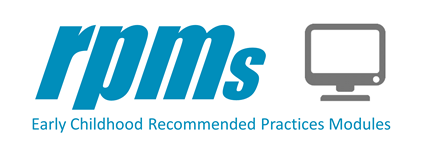Module 3: Environment
Welcome to this Module on Environment based on the Division for Early Childhood (DEC) Recommended Practices. In this module you will learn the components of a child’s natural and inclusive environment and why attending to the environment is crucial for children with disabilities.
Learning Objectives
Completion of this module will enable you to:
- Recognize the physical, temporal, and social environment
- Identify when modifications should be made to make the environment more inclusive
- Make modifications to environments based on what is presented in this module
Each module developed by the Recommended Practices Module (RPM) project introduces and illustrates the practices grouped in one of the eight topic areas in the Division for Early Childhood (DEC) Recommended Practices. The DEC Recommended Practices were developed to provide guidance about the most effective ways to improve the learning outcomes and promote the development of young children, birth through five years of age, who have or are at-risk for developmental delays or disabilities.
Introduction to the RPM Crosswalks
Module 3 is aligned to the topic area of environment and focuses on the following recommended practices:
Recommended Practices
- E1. Practitioners provide services and supports in natural and inclusive environments during daily routines and activities to promote the child’s access to and participation in learning experiences.
- E2. Practitioners consider Universal Design for Learning principles to create accessible environments.
- E3. Practitioners work with the family and other adults to modify and adapt the physical, social, and temporal environments to promote each child’s access to and participation in learning experiences.
- E4. Practitioners work with families and other adults to identify each child’s needs for assistive technology to promote access to and participation in learning experiences.
- E5. Practitioners work with families and other adults to acquire or create appropriate assistive technology to promote each child’s access to and participation in learning experiences.
- E6. Practitioners create environments that provide opportunities for movement and regular physical activity to maintain or improve fitness, wellness, and development across domains.
